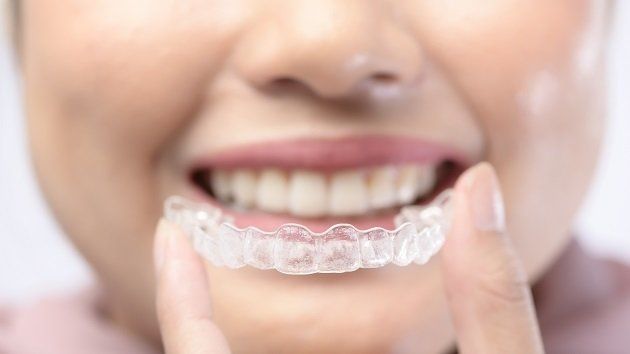The Ultimate Comparison: Invisalign vs. Traditional Braces for Adults
The Ultimate Comparison: Invisalign vs. Traditional Braces for Adults
Blog Article
Invisalign vs. Typical Braces: Which Choice Is Right for You?
When considering orthodontic therapy, the option in between Invisalign and traditional dental braces presents several vital elements that warrant cautious evaluation. Invisalign supplies a discreet option with detachable aligners, while conventional braces supply a more visible yet reliable option for severe imbalance.
Introduction of Treatment Alternatives

In comparison, standard dental braces include steel brackets and wires that are adhered to the teeth. This method uses constant pressure gradually to attain positioning. While effective for complex orthodontic problems, traditional dental braces call for regular check outs for modifications and can present challenges in preserving oral health because of the difficulty of cleaning up around wires and braces.
Both alternatives have their benefits, and the selection frequently pivots on particular oral problems, way of life preferences, and client conformity. Eventually, seeking advice from an orthodontic specialist is important for determining the most ideal treatment strategy tailored to private demands. Understanding the nuances of each option can significantly influence the total success of orthodontic treatment.
Aesthetic Considerations
A significant variable influencing the choice between Invisalign and traditional dental braces is the visual allure each treatment provides. Invisalign aligners are crafted from clear plastic, making them virtually unseen when worn.
In comparison, traditional dental braces include metal braces and cables, which can be a lot more recognizable. While innovations in orthodontic innovation have actually resulted in the growth of smaller braces and tinted elastics, traditional braces still maintain a more conspicuous account. For some individuals, the presence of braces may hinder them from seeking needed treatment.
Eventually, the selection between Invisalign and standard dental braces may rest on individual preferences relating to aesthetic appeals. Patients who focus on discernment frequently lean towards Invisalign, while those that are much less concerned regarding presence may choose for typical braces. Understanding the visual effects of each option is critical for making an informed decision that straightens with one's lifestyle and preferences.
Convenience and Convenience

In regards to comfort, Invisalign aligners are removable, enabling people to appreciate their favorite foods without constraint and keep ideal oral health. Brushing and flossing are streamlined, as the aligners can be secured during these regimens, whereas standard braces call for cautious maneuvering around braces and cables.
In contrast, typical dental braces necessitate routine adjustments, making them much less hassle-free for those with active schedules. In general, the convenience and comfort of Invisalign make it an enticing option for several individuals seeking orthodontic therapy.
Therapy Period and Performance
While both Invisalign and traditional official statement braces are effective in remedying oral imbalances, the duration of treatment can vary significantly between the two choices. Generally, Invisalign therapy can take anywhere from 12 to 18 months, relying on the intricacy of the instance. The clear aligners work by gradually shifting teeth into their preferred placements, and normal follow-ups with an orthodontist aid ensure progress stays on the right track.
In comparison, typical dental braces often require a longer commitment, typically ranging from 18 months to three years. This is because of their fixed nature and making use of cords and braces, which can be more effective for intricate instances and extreme imbalances (Invisalign). The therapy effectiveness of conventional braces is well-documented, as they enable specific adjustments and better control over tooth activity
Eventually, the option between Invisalign and conventional braces might depend upon both the expected treatment duration and the details oral problems at hand. Consulting with an orthodontist is essential, as they can provide customized referrals based on individual demands, ensuring the picked approach that site lines up with desired end results and durations.
Cost Comparison and Insurance Coverage Choices
Cost plays a substantial duty in the decision-making procedure for people thinking about orthodontic therapy, whether deciding for Invisalign or conventional dental braces. Generally, the cost of Invisalign arrays from $3,000 to $8,000, while conventional dental braces normally cost in between $2,000 and $6,000. Elements affecting these expenses consist of the complexity of the instance, the duration of therapy, and geographical location.
Several dental insurance coverage strategies supply partial coverage for orthodontic see this page therapies, however the specifics can differ commonly. Usually, conventional dental braces may be extra often covered by insurance coverage strategies contrasted to Invisalign, which some insurers categorize as a cosmetic procedure.
Furthermore, a number of orthodontic techniques offer flexible layaway plan, making both therapy choices extra easily accessible. Individuals need to inquire about prospective financing choices and price cuts for ahead of time settlements. Evaluating the overall expense, including insurance coverage benefits and layaway plan, is crucial for making an educated choice that straightens with both visual preferences and budget plan considerations.

Verdict
In recap, the option between Invisalign and standard braces depends upon multiple factors, consisting of visual choices, comfort, treatment period, and price. Invisalign uses a discreet, removable option that promotes dental hygiene and nutritional flexibility, while standard braces might be more suitable for complex dental issues and usually come with a reduced price point. Inevitably, examination with an orthodontist is vital to assess private situations and figure out one of the most proper therapy option for attaining optimal oral placement.
When considering orthodontic treatment, the selection in between Invisalign and conventional braces provides a number of important variables that merit mindful examination.Contrasting Invisalign and traditional dental braces exposes distinct therapy options for orthodontic improvement.While both Invisalign and standard dental braces are reliable in remedying dental imbalances, the duration of treatment can vary dramatically in between the two choices.Price plays a considerable duty in the decision-making process for people considering orthodontic treatment, whether deciding for Invisalign or traditional braces.In recap, the choice between Invisalign and typical braces hinges on several factors, including aesthetic choices, convenience, treatment duration, and expense.
Report this page